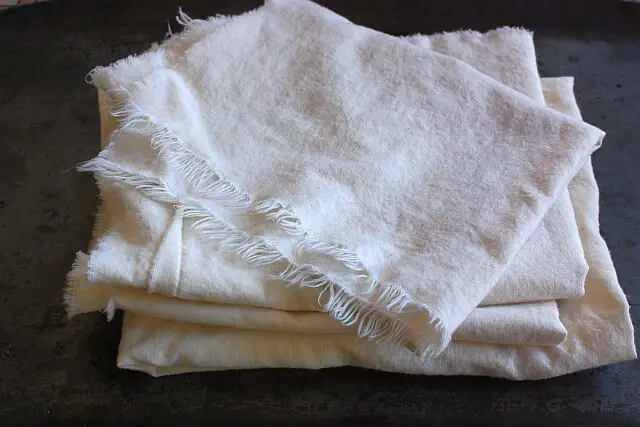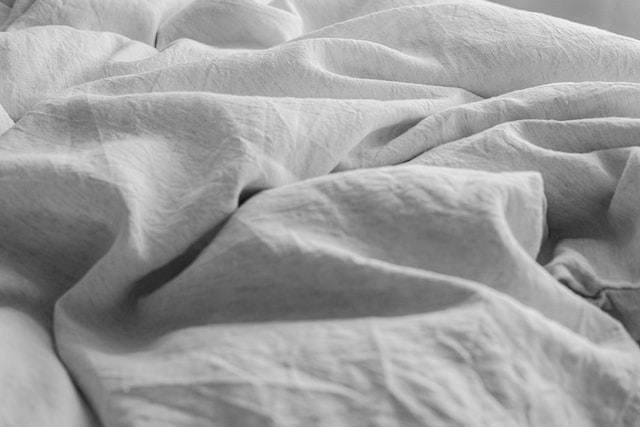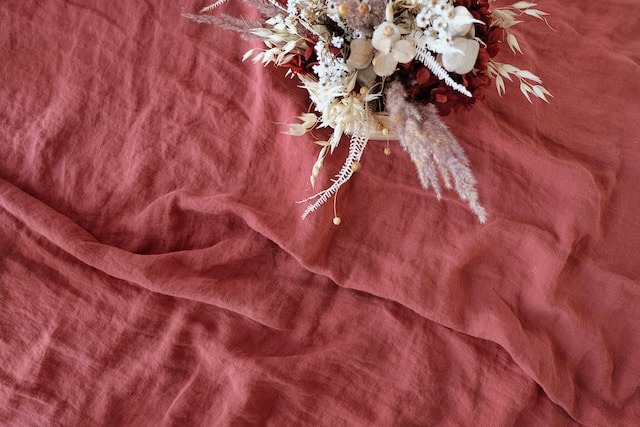Muslin is a lightweight cotton fabric that is perfect for making baby clothes, linens are more durable and ideal for home décor items such as tablecloths, curtains, and bedding. Muslin’s softness makes it comfortable to wear against the skin while linen’s sturdiness allows it to withstand heavy usage.
Muslin
(Photo by Andrea Nguyen on Flickr)

Muslin is a lightweight and loosely-woven fabric that has been popular for centuries. It’s made from cotton or cotton blends, and has a plain weave with a soft texture. Muslin is often used for clothing, such as dresses and blouses, due to its breathability and comfort.
One of the main benefits of muslin is its versatility. It can be easily dyed or printed on to create unique patterns and designs. Muslin also works well in various sewing projects such as quilts, curtains, and even diapers!
When it comes to caring for muslin fabrics, they are generally easy-to-care-for materials which tend not to require any special treatment. They can usually be machine washed with similar colors using cold water settings.
Despite their many advantages, there are some disadvantages associated with muslin fabrics too. Their light-weight nature means that they may not offer much warmth during colder seasons nor will they hold up under heavy wear-and-tear situations.
Linen
(Photo by Jacinta Christos on Unsplash )

Linen is a popular fabric that has been in use for thousands of years. It is made from the fibers of the flax plant, which gives it its distinct texture and durability. One of the key characteristics of linen is its breathability, which makes it ideal for clothing items like shirts, dresses, and pants.
Linen also has a natural ability to absorb moisture, making it perfect for warm weather wear. When compared to other fabrics like cotton or polyester, linen tends to be more lightweight and airy. This is why many people choose linen pieces when they want something comfortable yet stylish during summer months.
Another benefit of using linen is that it gets softer with every wash without losing shape or color over time. Unlike other fabrics that might pill after multiple washes or fade quickly in sunlight exposure.
While some may find linen’s tendency to wrinkle frustrating, others see this as part of its charm – giving off an effortless casual vibe even when dressed up. With proper care and handling such as gentle washing cycles & ironing within recommended temperature ranges (if needed), Linen can last you years with minimal maintenance while providing unmatched comfort & style!
Muslin Vs. Linen – Key differences
Muslin is a lightweight cotton fabric that is very breathable and soft to the touch. It’s perfect for summer dresses, baby clothes, or curtains due to its airy texture. On the other hand, linen is made from flax fibers and has a more textured feel than muslin. It’s known for being durable and absorbent, making it ideal for towels, tablecloths or bedding.
One of the main differences between muslin and linen is their cost. Linen garments tend to be pricier because of the time-consuming process involved in creating them. Muslin clothes can be cheaper but still retain their quality even after multiple washes.
When it comes to caring for these fabrics, they require different approaches as well. Muslin can shrink easily when washed at high temperatures so it’s recommended to use cold water instead. In contrast, linen should be washed on high heat as this helps soften any wrinkles that may have formed during wear.
Both muslin and linen have unique qualities that make them stand out from one another in terms of texture, durability and uses within various industries such as fashion or home décor design!
How to care for muslin and linen fabrics
Caring for muslin and linen fabrics is quite easy, but there are a few things to keep in mind. First, always check the care label as some blends may require special attention.
For both muslin and linen, it’s best to wash them separately from other clothes using mild detergent in cool water. Avoid using bleach or fabric softeners as they can damage the fibers and cause discoloration.
After washing, hang or lay flat to dry instead of putting them in the dryer. This helps prevent shrinkage and maintains their shape.
If ironing is necessary, use a low heat setting for muslin and a high heat setting for linen. Muslin may wrinkle easily due to its lightweight nature but can be steamed out with ease.
Taking good care of your muslin and linen fabrics will ensure that they last longer while maintaining their softness and texture over time.
What is muslin used for?
Muslin is a lightweight, plain-woven fabric that has been around for centuries. Its versatility makes it perfect for many uses. One of the most common uses for muslin is in fashion design – particularly as a lining material for dresses and skirts.
Muslin’s softness and breathability also make it an ideal choice for baby clothing such as swaddles, blankets, and burp cloths. Muslin can be easily dyed or printed on which allows designers to create unique patterns that appeal to both adults and children alike.
In addition to its use in fashion, muslin is commonly used in home décor projects such as curtains, tablecloths, napkins or upholstery covers due to its durability and resistance to wrinkles.
Muslin’s natural properties also lend themselves well to culinary arts where they are utilized primarily by chefs when making cheese cloth bags or tea bags because they allow the desired liquid through while holding back solids.
Muslin’s versatility makes it one of the most widely used fabrics across multiple industries; from textiles and culinary arts all the way down to photography studios who use them frequently behind their cameras during photo shoots due to their ability diffuse light evenly.
What is linen used for?
Linen is a versatile fabric that has been used for centuries in various applications. It is known for its durability, breathability, and natural sheen. Due to these properties, linen finds itself as the go-to choice for many different uses.
One of the primary uses of linen is clothing. It’s often used to create lightweight summer clothes due to its breathable nature. Additionally, it can be blended with other fibers such as cotton or silk to get added softness and texture.
Linen also finds its use in home décor items like tablecloths, napkins, curtains, and bed sheets. Its subtle luster gives an elegant touch when paired with classic designs.
Another popular application of linen includes upholstery fabrics where it adds a timeless quality to chairs and sofas. Linen is also widely used in making towels because of its water-absorbent property.
Moreover, owing to its strength and ability to repel dirt naturally, it’s commonly utilized by artists as canvases since it doesn’t deteriorate quickly over time.
Linen has found extensive utilization through the years from fashion designers who love their versatility down to homeowners who embrace them into their interiors adding elegance at every turn possible!
What are the 3 types of linen?
Linen is a versatile and popular fabric that has been used for centuries. It’s made from the fibers of the flax plant, which gives it its characteristic durability and strength. There are three main types of linen: Plain weave, Twill weave, and Damask.
Plain weave linen is the most common type and is known for its smooth texture. It’s created by weaving the threads over and under each other in a simple pattern, resulting in a flat surface with no visible pattern.
Twill weave linen is characterized by a diagonal ribbed pattern that runs throughout the fabric. The threads are woven over two or more threads before going under one thread to create this unique look.
Damask linen is an intricate type of linen that features designs woven into the fabric using contrasting colors of thread. This results in an elegant finish perfect for formal occasions such as weddings or fine dining experiences.
Each type of linen has its own unique characteristics that make it suitable for different purposes. Plain weave works well for everyday clothing while twill weave provides extra durability making it ideal for home décor items like curtains or tablecloths. Damask is best suited to luxurious textiles like bedding or upholstery due to its intricate design work.
The disadvantages of muslin and linen
One of the main drawbacks of muslin is that it can be quite sheer, which means it may not provide enough coverage for certain garments. Additionally, muslin tends to wrinkle easily and may require frequent ironing or steaming to maintain its crisp appearance.
Linen also has its own set of shortcomings. While it’s a durable fabric that can last for years when cared for properly, linen does tend to shrink if washed improperly or exposed to high heat. It can also be somewhat difficult to work with due to its tendency to fray at the edges.
Both fabrics also have a relatively high price point compared to other materials like cotton or polyester blends, which could make them less accessible for those on a budget.
While there are certainly benefits to using muslin and linen in your sewing projects, it’s important to keep these potential drawbacks in mind before making your final decision.
Featured Image By – Katsia Jazwinska on Unsplash








